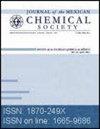加工阶段对微波保鲜番茄泥生物活性的影响
IF 1.1
4区 化学
Q3 CHEMISTRY, MULTIDISCIPLINARY
引用次数: 0
摘要
摘要西红柿是生物活性化合物的天然来源。这些物质大多积聚在番茄皮和种子中,果肉是番茄制品的主要成分,果肉中含量很少。技术工艺的应用以及植物品种、栽培和收获条件对番茄果实和番茄制品中酚类物质的含量和组成有显著影响。为了提高其生物活性,本研究以墨西哥产番茄为原料,在番茄的种子和果皮的基础上制备了番茄泥。对各阶段的生物活性化合物进行了评价。生物活性化合物的变化发生在番茄汁浓缩阶段。传统的巴氏灭菌法和微波单独处理时,生物活性化合物的保留率相似,但微波使用的时间较短。添加籽和皮的番茄泥具有较高的生物活性。巴氏灭菌和微波处理之间的微生物活性没有显着差异,因为两种热处理实现了相似的微生物灭活。HPLC法鉴定绿原酸、芦丁、白藜芦醇、槲皮素、柚皮素。与巴氏消毒的番茄酱相比,微波处理的番茄酱呈现出更少的酸性味道,更强烈的红色和更令人愉快的香气。主成分分析表明,影响番茄浆中多酚含量的加工阶段分别对应于热处理阶段和浓缩阶段。Resumen。番茄是一种天然的生物活性物质。从物质上看,积累的物质是由番茄的物质构成的,而不是由番茄的物质构成的物质构成的物质构成的物质。La aplicación de procos tecnológicos, así como La variedad de plantas, el栽培通过las conditiones de cosecha, pued影响显著的el contenido y La composición de compuestos fenólicos en el fruto del del tomato通过los products a base de tomate。关于生物活性的辩论,在此提出了investigación se preparó关于番茄采购的补充意见,并提出了墨西哥原产番茄的利用问题。对计算机生物活性的评价是一种新方法。variación de los compuestos bioactivos ocurrió durante La etapa de concentración del jugo de tomate。La retención de compuestos bioactivos类似于La pasteurización常规的生物处理,在微观上应用于形式独立的,在禁运,el microondas usó在时间上。番茄的来源:番茄的来源:植物的来源:植物的来源:植物的来源:植物的来源:植物的来源:植物的来源:植物的来源:植物的来源:植物的来源。在细菌活性与microbiológica中心和pasteurización之间没有显著差异;在细菌活性与microbiológica中心和pasteurización之间没有显著差异;在细菌活性与microbiológica中心和pasteurización之间没有显著差异。高效液相色谱法(HPLC)鉴别出了ácido克罗芬、芦丁、白藜芦醇、槲皮素和柚皮素。El purpurise de tomate tratado con microondas presentó un sabor menos ácido, un color rojo más浓烈的香气más可降解的en comparación con El purpurise de tomate pasteurizado。1 . análisis PCA 1 . mostró用数据分析过程中发生的事件2 . polifenólico用数据分析过程中发生的事件2 . elaboración用数据分析过程中发生的事件2 .使用数据分析过程中发生的事件2 . concentración用数据分析过程中发生的事件。本文章由计算机程序翻译,如有差异,请以英文原文为准。
Effect of Processing Stage on the Bioactives of Tomato Purees Supplemented Preserved by Microwaves
Abstract. Tomatoes are a natural source of bioactive compounds. Most of these substances accumulate in the tomato skin and seeds and are scarce in the pulp, which is the main ingredient of tomato products. The application of technological processes as well as plant variety, cultivation, and harvesting conditions, can significantly affect the content and composition of phenolics in tomato fruit and tomato-based products. To increase the content of bioactive, in the present investigation a tomato puree supplemented with the seeds and skin of the fruit was prepared using tomatoes of Mexican origin. The bioactive compounds at each stage of the process were evaluated. The variation in bioactive compounds occurred during the tomato juice concentration stage. The retention of bioactive compounds was similar when conventional pasteurization and microwave treatment were applied independently, however, the microwave used a lower time. Tomato puree supplemented with seeds and skin presented a higher content of bioactive. There were no significant differences in the microbiological activity between pasteurization and microwave treatment since both heat treatments achieved similar microbial inactivation. Chlorogenic acid, rutin, resveratrol, quercetin, and naringenin were identified by HPLC. The microwave-treated tomato puree presented a less acidic taste, a more intense red color, and a more pleasant aroma compared to the pasteurized tomato puree. The PCA analysis showed that the processing stages that affect the polyphenolic content in the elaboration of tomato purees corresponded to the heat treatments appliednd and the concentration stage.
Resumen. Los tomates son una fuente natural de bioactivos. La mayoría de estas sustancias se acumulan en la piel y las semillas del tomate y son escasas en la pulpa, que es el ingrediente principal de los productos derivados del tomate. La aplicación de procesos tecnológicos, así como la variedad de plantas, el cultivo y las condiciones de cosecha, pueden afectar significativamente el contenido y la composición de compuestos fenólicos en el fruto del tomate y los productos a base de tomate. Para aumentar el contenido de bioactivos, en la presente investigación se preparó un puré de tomate suplementado con las semillas y la piel del fruto utilizando tomates de origen mexicano. Se evaluaron los compuestos bioactivos en cada etapa del proceso. La variación de los compuestos bioactivos ocurrió durante la etapa de concentración del jugo de tomate. La retención de compuestos bioactivos fue similar cuando la pasteurización convencional y el tratamiento con microondas se aplicaron de forma independiente, sin embargo, el microondas usó un tiempo menor. El puré de tomate suplementado con semillas y piel presentó mayor contenido de bioactivos. No hubo diferencias significativas en la actividad microbiológica entre la pasteurización y el tratamiento con microondas ya que ambos tratamientos térmicos lograron una inactivación microbiana similar. Por HPLC se identificaron ácido clorogénico, rutina, resveratrol, quercetina y naringenina. El puré de tomate tratado con microondas presentó un sabor menos ácido, un color rojo más intenso y un aroma más agradable en comparación con el puré de tomate pasteurizado. El análisis PCA mostró que las etapas de procesamiento que inciden en el contenido polifenólico en la elaboración de purés de tomate correspondieron a los tratamientos térmicos aplicados y la etapa de concentración.
求助全文
通过发布文献求助,成功后即可免费获取论文全文。
去求助
来源期刊
CiteScore
2.00
自引率
0.00%
发文量
0
审稿时长
6-12 weeks
期刊介绍:
The Journal of the Mexican Chemical Society (J. Mex. Chem. Soc.) is a scientific, blind, peer reviewed, and open access, free of charge publication that covers all areas of chemistry and its sub-disciplines (i.e. medicinal chemistry, natural products, electrochemistry, material science, computational chemistry, organic chemistry, bionirganic chemistry, etc). It is devoted to facilitating the worldwide advancement of our understanding of chemistry. It will primarily publish original contributions of research in all branches of the theory and practice of chemistry in its broadest context as well as critical reviews in active areas of chemical research where the author has published significant contribution. The J. Mex. Chem. Soc. is a quarterly publication which language of submission and publication is English. To be suitable for publication in J. Mex. Chem. Soc., manuscripts must describe novel aspects of chemistry, high quality of results and discussion an excellent bibliographic support, and contribute to the development of the field. Routine or incremental work are not suitable for publication in J. Mex. Chem. Soc. Authors are encouraged to send contributions in electronic form. Our online submission system guides you stepwise through the process of entering your article details and uploading your files.

 求助内容:
求助内容: 应助结果提醒方式:
应助结果提醒方式:


